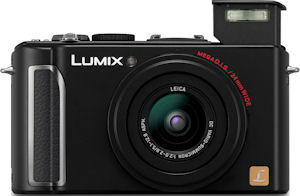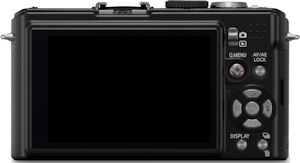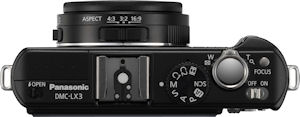 Lumix LX3 - high sensitivity sensor, 24mm wide angle
Lumix LX3 - high sensitivity sensor, 24mm wide angle
By
Mike Tomkins
(Monday, July 21, 2008 - 16:28 EDT)
Rounding out its digicam announcements for the day is perhaps the most interesting of the group - Matsushita's new Panasonic Lumix DMC-LX3.
The Panasonic Lumix LX3 has a newly developed 1/1.63" CCD image sensor with 10.1 effective megapixel resolution, which is said to offer 40% higher sensitivity along with a 35% increase in saturation. Panasonic has coupled this to an image stabilized, Leica branded 2.5x optical zoom lens with an impressive 24mm wide angle. The Panasonic LX3's lens has a maximum aperture from f/2.0 to f/2.8 across the zoom range, and a Macro focusing distance of just one centimeter at wide angle. The Panasonic LX3 offers a large 3.0" LCD display, and while there's no built-in viewfinder, an optional external viewfinder can be attached to the LX3's flash hot shoe. The Panasonic DMC-LX3 has a multi-area autofocus system with both face detection and object tracking. ISO sensitivity ordinarily ranges from 100 to 3200, with the ability to extend this as far as ISO 6400 equivalent in High Sensitivity mode. Shutter speeds in the Panasonic LX3 range from 1/2000 to 60 seconds. The Panasonic DMC-LX3 uses Intelligent Multiple, Center-Weighted or Spot metering, and has nine white balance settings. A whopping selection of twenty four scene modes let users tailor the look of their images without needing to understand the subtleties of shutter speeds and apertures. As well as these, for the creative types there are both manual and aperture- / shutter-priority modes on the Panasonic LX3. An interesting feature is the ability to capture three images in 4:3, 3:2 and 16:9 aspect ratios simultaneously, courtesy of a new Multi Aspect mode. A five mode flash strobe includes both red-eye reduction and slow-sync capabilities, and has a rated range of up to 8.3 meters at wide angle, or 5.9 meters at telephoto. As previously mentioned, there's also a hot shoe for external flash strobes. As well as Raw and JPEG still images, the Panasonic LX3 can capture movies with sound at up to high definition 1280 x 720 pixel resolution, although the compression used is the older QuickTime Motion JPEG type, so file sizes are likely to be fairly high. The Panasonic Lumix DMC-LX3 stores its images and movies on Secure Digital or MultiMediaCards, including the newer SDHC types. There's also a generous 50MB of built-in memory. Connectivity options include USB 2.0 High-Speed, standard definition NTSC video output, and high-def component video output (although the cable for this is an optional extra). Power comes from a 3.7V, 1150mAh proprietary Lithium Ion battery, rated as good for 380 shots on a charge to CIPA testing standards. The Panasonic Lumix DMC-LX3 will ship this August, with expected pricing of $500 or thereabouts. | Panasonic Lumix DMC-LX3 |  | | General | | Camera Type | Compact | | Manufacturer | Panasonic | | Model Number | DMC-LX3 | | Dimensions | 4.3 x 2.3 x 1.1"
108.7 x 59.5 x 27.1mm | | Weight | 265.0 g
9.3 oz | | Planned Price | $500.00 | | Planned Availability | 2008 | | Image Capture | | Sensor Type | 1/1.63" CCD
11.30 megapixels (total)
10.10 megapixels (effective) | | Filter Type | RGBG | | Aspect Ratio | 4:3, 16:9 | | Image Dimensions | 3648 x 2736 (10.0 megapixels)
3776 x 2520 (9.5 megapixels, interpolated)
3968 x 2232 (8.9 megapixels)
3072 x 2304 (7.1 megapixels)
3168 x 2112 (6.7 megapixels)
3328 x 1872 (6.2 megapixels)
2560 x 1920 (4.9 megapixels)
2656 x 1768 (4.7 megapixels)
2784 x 1568 (4.4 megapixels)
2048 x 1536 (3.1 megapixels)
2112 x 1408 (3.0 megapixels)
2208 x 1248 (2.8 megapixels)
2048 x 1360 (2.8 megapixels)
1920 x 1080 (2.1 megapixels)
1600 x 1200 (1.9 megapixels)
640 x 480 (0.3 megapixels)
| | Capture Speed | Standard: 2.5 frames per second for 4 frames | | Image Quality | 3 levels | | Image Preview / Review | | Viewfinder | Yes, Optional external viewfinder | | LCD | 3.0", 460,000 pixels
100% field of view | | Lens | | Lens Type | LEICA DC VARIO-SUMMICRON
2.5x optical zoom | | Image Stabilization | Yes | | Focal Length | 5.1 - 12.8mm (actual)
24 - 60mm (35mm equivalent) | | Aperture Range | f/2.0 (wide) / f/2.8 (tele) - ??? | | Focusing System | Multi-area with face detection and tracking with AF assist lamp
Manual Focus possible (0) steps | | Focusing Range | Normal: 20" - infinity (50 cm - infinity)
Macro: 0.4" - infinity (1.0 cm - infinity) | | Exposure | | ISO Sensitivity | Auto, High Sensitivity Auto (1600-6400), 100, 200, 400, 800, 1600, 3200 | | Shutter Speed | 60 - 1/2000 second | | Exposure Modes | Aperture, Shutter, Manual | | Metering Modes | Intelligent Multiple, Center-Weighted, Spot | | Exposure Compensation | +/- 2.0EV in 1/3EV increments | | White Balance | Image Sensor - Auto, Daylight, Cloudy, Shade, Flash, Halogen, Color Temperature, White Set 1, White Set 2, Manual | | Internal Flash | Modes: Auto, Auto w/ Red-Eye Reduction, On, Slow-Sync w/ Red-Eye Reduction, Off
Range: Wide: 0.8 - 8.3m; Tele: 0.3 - 5.9m (ISO Auto) | | Flash Exposure Compensation | +/- 2.0EV in 1/3EV increments | | Creative | | Scene Modes | Portrait, Soft Skin, Self-Portrait, Scenery, Sports, Night Portrait, Night Scenery, Food, Party, Candle Light, Baby1, Baby2, Pet, Sunset, High sensitivity, Starry Sky, Fireworks, Beach, Snow, Aerial photo, Hi-Speed Burst, Flash-Burst, Film Grain, Pin Hole | | Digital Zoom | 4x | | Self Timer | Yes, 2 or 10 seconds | | Time Lapse | No | | Movie Format | QuickTime Motion JPEG with audio | | Storage | | Recording Medium | SD/MMC, Built-in | | File System | Complies with Design Rule for Camera File System (DCF) | | File Format | CCD-RAW, JPEG (EXIF 2.21) | | Connectivity | | Video | Yes | | Computer | USB 2.0 High Speed | | Other | DC Input | | Power | | Battery Type | 3.7V 1150mAh Lithium Ion rechargeable | | Battery Form Factor | Proprietary | | Product Bundle | | Software | PHOTOfunSTUDIO Viewer 2.1E, ArcSoft MediaImpression, ArcSoft Panorama Maker, SilkyPix Developer Studio 3.0SE | | Battery / Charger | 1 x proprietary Lithium Ion rechargeable battery and charger | | Flash Memory | 50.0MB built-in memory | | Other | | Digital Print Order Format (DPOF) compliant | Yes | | PictBridge Compliant | Yes | | Internal Microphone | Yes | | Internal Speaker | Yes | | Tripod Mount | Yes | | Remote Control | No | | More Photos |  |  |  | | |
|
Original Source Press Release:
| PANASONIC ANNOUNCES MUCH-ANTICIPATED ADDITION TO ITS LX-SERIES OF LUMIX DIGITAL CAMERAS New LUMIX DMC-LX3 Combines Enhanced CCD Technology, LEICA Lens, and a Wide-Range of Manual Shooting Controls For Increased Creativity SECAUCUS, N.J. (July 21, 2008) - Panasonic today introduced the LUMIX DMC-LX3 digital camera, the successor to the highly-regarded and popular DMC-LX2. Designed for easy, creative shooting, and high-performance in low-light conditions, the DMC-LX3 features a F2.0 24mm LEICA DC VARIO-SUMMICRON lens, 10.1 megapixels and an ultra-sensitive 1/1.63-inch CCD developed specifically for this model. By combining a high-quality lens and sensor ready for a variety of shooting conditions with a wide-range of accessories and manual controls, the DMC-LX3 is ideal for professional photographers and serious amateurs looking for a compact digital camera that furthers their creative photography. At the heart of the DMC-LX3, is its 1/1.63-inch CCD. Making the intentional choice to limit the number of megapixels to 10.1 on its CCD, Panasonic was able to give more space for each pixel and also redesigned the peripheral circuits and other components to further minimize noise generation. As a result, sensitivity is almost 40 percent higher and saturation is increased by 35 percent, when compared to Panasonic’s 10 MP digital cameras*, giving the DMC-LX3 outstanding image quality and a wide dynamic range, and meeting the demand for a camera that works optimally in low-light environments. The CCD is also capable of reproducing images in three aspect ratios – 4:3, 3:2 or 16:9. The new Multi Aspect mode allows the camera to take an image in all three aspect ratios simultaneously, allowing users to choose the version that best suits their needs. “With the strong response towards the DMC-LX2, Panasonic has taken its technology a step further by upgrading several key components that we think will make the LX3 another win,” said David Briganti, National Marketing Manager, Imaging, Panasonic Consumer Electronics Company. “With the enhanced CCD and extensive manual and automatic functions, the DMC-LX3 is ideal for photographers looking for a full-featured compact digital camera with some DSLR-like characteristics and a wide-range of optional accessories.” Another major upgrade to the LX3 is the F2.0 24mm ultra wide-angle LEICA DC VARIO-SUMMICRON lens. The F2.0 is about twice as bright as a F2.8 lens and can shoot at higher shutter speeds to capture clear, blur-free images in dimly lit environments. In addition, the 24mm lens captures approximately a 213% larger viewing angle than a normal 35mm camera and 136% larger compared to a 28mm wide-angle lens. The lens unit consists of eight elements in six groups with four aspherical lenses with four aspherical surfaces. As a result of the F2.0 lens, the LX3 produces high resolution and minimal distortion and artifacts – such as chromatic aberrations, ghosting and flaring. The LX3 also incorporates the Venus Engine IV, which provides more advanced signal processing technology for producing higher-quality images with reduced noise in both luminance signal and chromatic signal processing – as compared to the Venus Engine III. The Venus Engine IV supports high sensitivity recording enabling the DMC-LX3 to record at up to ISO 3200 at full resolution and even up to ISO 6400 when using high sensitivity mode, enough to capture subjects in low lighting without using a flash**. The Venus Engine IV also supports a faster response time, allowing the camera to shoot 2.5 shots per second at full resolution and six shots per second in High-Speed Burst mode. The easy-to-use joystick operation which was featured in its predecessor continues with the LX3, as its intuitive design makes selecting different settings on the camera, including focus, aperture and shutter speed – easy and quick. Other convenient design elements include a switch on the side of the lens barrel that allows the user to quickly change the focus modes between Manual Focus, Auto Focus and Macro Auto Focus. When choosing Manual Focus, the focus distance and the depth of field according to the zoom range and aperture is also displayed. For setting white balance, the LX3 provides a new color temperature display function, and still includes the Two-Axis white balance adjustment settings offered in previous models. Users can also customize and store their own personal settings of up to four unique functions and instantly recall them later using the mode dial. Furthering its creative options, the LX3 also features a Film mode with six color types and three types of monochrome selections. Much like selecting from different film types, this function gives the user the flexibility and creative freedom to take more expressive digital photos. Also, when using the Multi-film mode, the LX3 produces a maximum of three images from a RAW file for the user to compare the different textures. Another new feature is the multiple-exposure feature, which lets the user create artistic photos by overlaying up to three consecutive images; while still viewing the last image on the 3.0-inch LCD screen. The LCD on the LX3 is new and improved with a 460,000-dot high resolution. While the LX3 allows full manual control for more advanced photography, it also includes Panasonic’s Intelligent Auto mode (iA), including the new feature, AF (auto focus) Tracking. AF Tracking automatically tracks the image subject and locks it into focus, making it easier for anyone to capture sharp, well-focused photos. The AF Tracking technology also improves face detection accuracy, allowing for crisp, sharp-focused shots even if the subject moves or turns their face. Other iA technologies include Intelligent Exposure, Digital Red-eye Correction, MEGA O.I.S, Intelligent ISO, Intelligent Scene Selector, Face Detection (up to 15 faces) and Quick AF. The DMC-LX3 has the ability to record High Definition (HD) video in 1280 x 720p at 24fps. With the newly added HD component output capability, still and moving pictures can be viewed by connecting the camera to a TV via an optional component cable (DMW-HDC2). In addition, the LX3 features Image Leveling, so when a captured image “leans” to the right or left because the camera was held at a slight angle when the photo was taken, this feature rotates the image to straighten it and crops the unnecessary edges. A number of accessories are also available to further expand the flexibility of the LX3 as more than just a typical point-and-shoot camera. The optional Wide Conversion Lens (DMW-LW46) brings the maximum wide angle to 18mm. Other optional accessories include: ND Filter (DMW-LND46)***, the new PL Filter (DMW-LPL46), the high-end aluminum External Optical Viewfinder (DMW-VF1); the GN22 Compact Flash mounts to the LX3’s hot shoe – a new feature for the LX-Series. The Panasonic LUMIX DMC-LX3 will be available in silver and black in August 2008 for a manufacturer’s suggested retail price of $499.95. For more information and to download the full specs, please visit www.panasonic.com/pressroom. *Compared with Panasonic LUMIX DMC-FX35 with 1/2.33” CCD.
** In 3-megapixel (4:3), 2.5-megapixel (3:2), 2-megapixel (16:9( recording.
*** Requires a lens adapter DMW-LA4. About Panasonic Consumer Electronics Company
Based in Secaucus, N.J., Panasonic Consumer Electronics Company is a Division of Panasonic Corporation of North America, the principal North American subsidiary of Matsushita Electric Industrial Co. Ltd. (NYSE: MC) and the hub of Panasonic's U.S. marketing, sales, service and R&D operations. In its commitment to provide consumers with extensive imaging resources, Panasonic LUMIX established the Digital Photo Academy, a series of nationwide workshops designed to instruct consumers how to optimize the features on their digital cameras and produce high-quality photos. Panasonic is honored to support OUR PLACE – The World’s Heritage, a project that will create the world’s largest photographic collection of UNESCO World Heritage sites, with acclaimed photographers exclusively using LUMIX digital cameras to capture all images. Information about Panasonic LUMIX digital still cameras and its affiliated programs is available at www.panasonic.com/dsc. # # # |
|